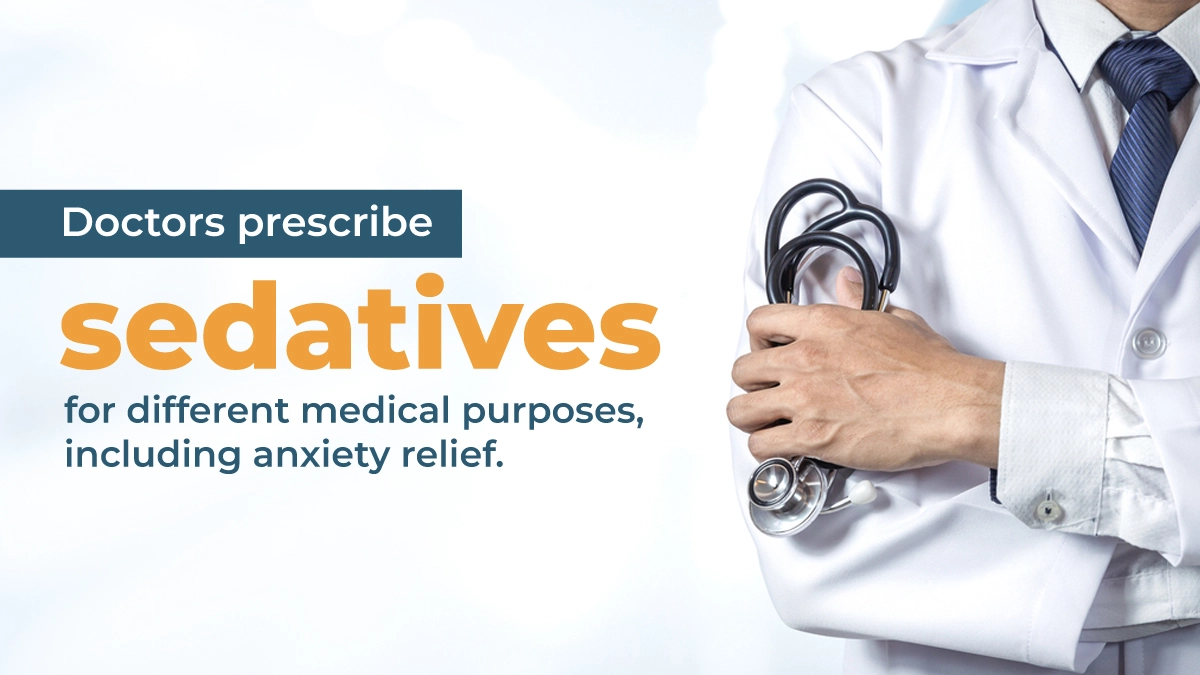Sedatives, commonly known as tranquilizers or depressants, are medications that slow down brain activity, inducing relaxation or drowsiness. Doctors often prescribe these drugs to alleviate anxiety, promote sleep, or manage certain medical conditions.
However, their use requires caution due to the potential for dependence, addiction, and adverse effects, primarily when used outside prescribed guidelines. Keep on reading as we delve deeper into the different aspects of this class of drugs.
Key Takeaways
Sedatives are prescription medications that depress the nervous system, causing relaxation and drowsiness. Here is what you need to know:
- Sedative drugs come in various forms, with each type serving specific medical purposes.
- Doctors prescribe sedatives for different medical purposes, including anxiety relief.
- Prolonged use of sedatives may lead to addiction, requiring comprehensive treatment.
Contact The Recovery Team at (800) 817-1247 today to get help in reclaiming your life from substance use disorder (SUD).
Understanding Sedatives
Sedatives are medications that work by depressing the central nervous system (CNS), resulting in a calming or sleep-inducing effect. They primarily act on the brain, affecting neurotransmitters and regulating communication between nerve cells.
Here’s a general overview of how they work:
Enhancing GABA Activity
Many prescription sedatives work by increasing the activity of gamma-aminobutyric acid (GABA), a neurotransmitter in the brain that has inhibitory effects. GABA helps to calm nerve activity, reducing anxiety and promoting relaxation.
Reducing Brain Activity
Sedative medications slow down brain activity by affecting specific receptors, such as GABA receptors, which inhibit the transmission of nerve signals. This suppression of nerve activity leads to decreased anxiety and drowsiness and sometimes induces sleep.
Duration and Metabolism
The duration of action varies among different sedatives. Some have short half-lives and are quickly metabolized by the body, leading to shorter-lasting effects. Others might have longer-lasting effects due to slower metabolism.
Types of Sedatives
Sedatives come in various forms, each with its unique characteristics and applications. Here is the breakdown of the different types:
Benzodiazepines
Benzodiazepines are a common type of sedative prescribed to manage anxiety, insomnia, and certain seizure disorders. Examples include diazepam (Valium), lorazepam (Ativan), and alprazolam (Xanax). They enhance the effects of GABA in the brain, resulting in relaxation and reduced anxiety. Doctors usually prescribe these drugs for short-term use due to the risk of dependence.
Barbiturates
Barbiturates were once widely used as sedatives and sleep aids but are now less commonly prescribed due to their higher risk of overdose and addiction. Examples include phenobarbital and secobarbital. These sedatives depress the central nervous system by increasing GABA activity, leading to sedation, muscle relaxation, and, in higher doses, anesthesia. However, their potential for overdose and addiction has led to more cautious prescribing practices.
Non-Benzodiazepine Hypnotics (Z-Drugs)
Z-drugs are a newer class of sedatives used to treat insomnia. Examples include zolpidem (Ambien), eszopiclone (Lunesta), and zaleplon (Sonata). They target specific GABA receptors, inducing sleep by calming the brain. Z-drugs are often prescribed for short-term insomnia and tend to have fewer risks of dependence compared to benzodiazepines or barbiturates.
Over-The-Counter Sedatives
Some sedatives are available without a prescription. These include antihistamines like diphenhydramine (in medications like Benadryl) and natural supplements like melatonin. While these options can help with occasional sleeplessness, they should be used cautiously and according to dosage instructions, as they may cause drowsiness or other side effects.
How Sedatives Are Administered
Sedatives can be administered in various ways, depending on the specific medication and the patient’s needs. Here are common methods of administering sedatives:
Oral Administration
Many sedatives are available in pill or liquid form and can be taken orally. This is a convenient and common method, especially for medications prescribed for anxiety or sleep disorders. Patients typically swallow a pill or ingest a liquid with water.
Intravenous (IV) Administration
Some sedatives are administered directly into the bloodstream through a vein. This method allows for a rapid onset of action, making it suitable for procedures requiring immediate sedation or patients who cannot take medications orally. An intravenous line is inserted, and the sedative is infused slowly.
Intramuscular (IM) Injection
Sedatives can be injected into a muscle, providing a relatively fast onset of action. This method is commonly used in emergencies or when intravenous access is challenging. It is less common than oral or intravenous administration for routine sedation.
Inhalation
Certain sedatives, particularly those used for general anesthesia or procedural sedation, can be administered through inhalation. This is often done using a mask or a breathing tube. Examples include nitrous oxide and certain anesthetic gasses.
Transdermal Administration
In some cases, sedatives may be administered through patches applied to the skin. The medication is absorbed through the skin and enters the bloodstream, providing a controlled and sustained release over time.
Sublingual or Buccal Administration
Some medications can be placed under the tongue (sublingual) or against the cheek (buccal) for absorption through the mucous membranes. This method allows for relatively rapid absorption and is often used when quick onset is necessary.
Medical Uses of Sedatives
Sedatives are versatile medications used across various medical applications. Here’s a breakdown of their roles in different medical scenarios:
Anxiety and Stress Reduction
Sedatives play a crucial role in alleviating anxiety and stress-related conditions. Medications like benzodiazepines and certain non-benzodiazepine drugs are prescribed to help manage symptoms of anxiety disorders, panic attacks, and generalized anxiety by calming the nervous system and reducing feelings of unease.
Sedation for Medical Procedures
Sedatives induce relaxation or sleepiness in healthcare settings before medical procedures or surgeries. They help patients feel more comfortable and less anxious during treatments ranging from minor dental procedures to complex surgeries, allowing medical professionals to perform interventions more effectively while ensuring patient comfort.
Insomnia Treatment
For individuals struggling with sleep disorders like insomnia, sedatives are sometimes prescribed to promote sleep. Medications such as Z-drugs or certain benzodiazepines are used for short periods to help initiate and maintain sleep patterns.
Seizure Management
Some sedatives, particularly benzodiazepines, are employed in managing seizures. They can help prevent or reduce the intensity and duration of seizures in conditions like epilepsy, providing relief to individuals experiencing these neurological episodes.
Alcohol Withdrawal
During alcohol withdrawal, which can be a challenging process for individuals dependent on alcohol, sedatives are occasionally used under medical supervision to manage withdrawal symptoms and prevent severe complications like seizures or delirium tremens.
Muscle Relaxation
Sedatives also have muscle-relaxing properties, beneficial for conditions involving muscle spasms or tension. They help ease muscle contractions and relieve conditions like muscle strains, back pain, or certain neurological disorders causing muscle stiffness.
Calming Effects in Psychiatry
In psychiatry, sedatives are used to produce calming effects in patients with certain mental health problems. They might be prescribed for short-term relief of acute symptoms in disorders such as bipolar disorder or schizophrenia to reduce agitation or anxiety.
Risks of Sedatives: Dependence and Withdrawal
Despite the therapeutic benefits, sedatives have a significant potential for dependence and withdrawal. The risk varies depending on the type of sedative, dosage, duration of use, and individual factors. Here’s a breakdown:
Tolerance
With continued use, the body might develop a tolerance to sedatives, meaning higher doses are needed to achieve the same effects. This can increase the risk of dependence and potential withdrawal symptoms.
Physical Dependence
Long-term use of sedatives can lead to physical dependence. The body adapts to the presence of the medication, requiring it to function normally. When someone becomes physically dependent, abrupt cessation or a rapid decrease in dosage can result in withdrawal symptoms.
Psychological Dependence
Alongside physical dependence, individuals may develop psychological dependence. This is characterized by a perceived need for the drug to cope with stress, anxiety, or other emotions, even if the physical dependence is not present.
Withdrawal Symptoms
Withdrawal symptoms can vary depending on the specific sedative but often include anxiety, restlessness, insomnia, irritability, sweating, tremors, and in severe cases, seizures. These symptoms can be uncomfortable and challenging to manage without medical supervision.
Given their potential for dependence and withdrawal, it’s essential for individuals using sedatives to follow prescribed dosages, communicate openly with healthcare providers, and be aware of the signs of dependence or withdrawal.
Sedative Addiction Treatment Options
Treating sedative addiction involves a comprehensive approach that addresses both the physical and psychological aspects of addiction. Here are some common components of the treatment process:
Medical Detoxification
A medical detox program, often the first step in the treatment, involves supervised withdrawal from sedatives in a safe environment. Healthcare professionals monitor and manage the withdrawal symptoms, ensuring a more comfortable and safer process as the body adjusts to the absence of the drug.
Rehabilitation Programs
Rehabilitation programs offer structured environments for individuals struggling with sedative addiction. Inpatient treatment programs involve residing at a treatment facility while receiving intensive therapy and support. Outpatient treatment programs allow individuals to live at home while attending therapy sessions and support groups regularly.
Therapy and Counseling
Therapy and counseling are integral parts of addiction treatment. Behavioral therapies, such as cognitive-behavioral therapy (CBT), aim to modify thought patterns and behaviors related to substance abuse. Counseling sessions provide a safe space for people to explore underlying issues contributing to their addiction.
Medication-Assisted Treatment (MAT)
Medication-assisted treatment (MAT) combines FDA-approved medications with counseling and behavioral therapies to manage addiction. For certain types of substance abuse, medications can help reduce cravings and withdrawal symptoms, facilitating the recovery process.
Support Groups
Support groups like Narcotics Anonymous (NA) or SMART Recovery offer a supportive community of individuals going through similar experiences. These groups encourage shared experiences and accountability, which can be vital in maintaining long-term recovery.
Lifestyle Changes
Making lifestyle changes is crucial in recovering from sedative dependence. This involves adopting healthier habits, finding new interests or hobbies, and building a strong support network. Making positive changes in diet, regular exercise, and stress management can contribute significantly to recovery.
The Recovery Team: Guiding Your Path to Freedom
Are you feeling trapped by sedative addiction? Here’s the good news: there’s a way out. At The Recovery Team, we aim to guide you towards a life free from addiction.
Our full continuum of care offers tailored programs featuring personalized therapy (individual and group sessions), expert medication management, and specialized treatment for dual diagnoses.
It’s not just about recovery; it’s about reclaiming a life you love, so wait no longer. Contact us at (800) 817-1247 today for more information.






